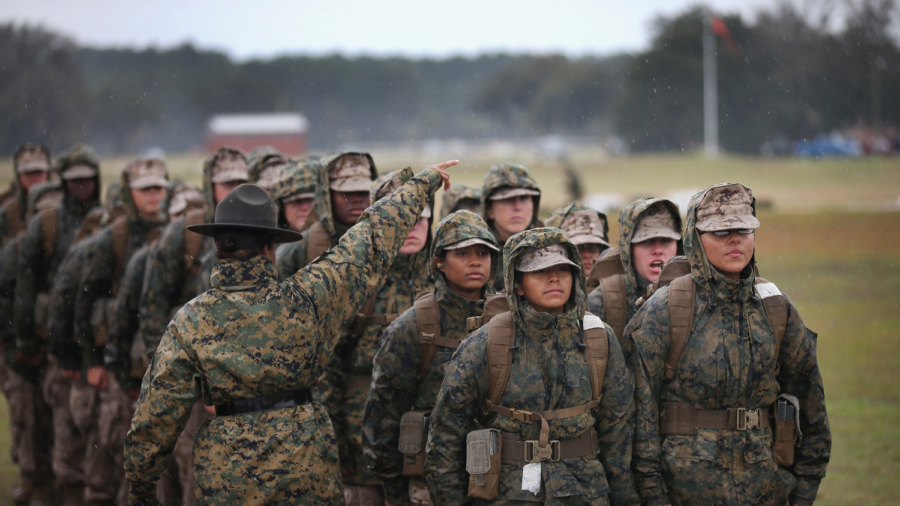The U.S. Marine Corps is set to officially disband its historically all-female recruit training unit and join the rest of the U.S. military branches that have already been training male and female recruits together.
On Wednesday, the Marines announced the deactivation date for its 4th Recruit Training Battalion—a training unit at Marine Corps Recruit Depot, Parris Island, South Carolina, that once trained female recruits exclusively. The 4th Recruit Training Battalion will officially disband during a deactivation ceremony at Parris Island on June 15.
“We will bid farewell to 4th Battalion in a deactivation ceremony that concludes her glorious tenure, closing the final chapter of integrating recruit training,” said Brig. Gen. Walker M. Field, Commanding General of MCRD Parris Island and the Eastern Recruiting Region. “We are forever grateful to the drill instructors, staff, and legions of Marines who so proudly call 4th Battalion home.”
The Marine Corps Parris Island boot camp has handled recruit training for all female recruits since 1949. The Marine Corps has cycled through several female recruit training units since 1949, including the 4th Recruit Training Battalion, which began operations on Nov. 1, 1986.
The entire U.S. military has been gradually integrating women into all aspects of service in recent years, including allowing women into infantry specialties. Along with this broader effort at integration, the Marine Corps has been working to bring females into all aspects of military training fully. In 2019, male recruits began training within the historically all-female 4th Recruit Training Battalion.
“Today, successful recruit training standardization makes an all-female training battalion unnecessary, as all recruits have been training in gender-integrated companies since 2022,” the Marine Corps said in its Wednesday press statement.
Before 2021, the Marine Corps had only female recruits trained at Parris Island, while Marine Corps Recruit Depot, San Diego, remained an exclusive training location for male recruits. However, by 2021, the San Diego recruit depot began receiving and training female recruits. Along with deactivating the 4th Recruit Training Battalion at Parris Island, the service is looking to eventually realign its personnel at both recruit training depots, with a goal to eventually have the San Diego location handle about half of all female recruits.
“This is a moment to celebrate the legacy of so many of our Marines who made the transformation through 4th Recruit Training Battalion,” said Gen. David H. Berger, the Commandant of the Marine Corps. “It’s also a moment to celebrate progress. I’m proud to see our male and female recruits benefit from having access to the quality of all our leaders—at Parris Island and San Diego—through an unchanging, tough, and realistic recruit training curriculum.”
Marine Corps Overwhelmingly Male
The U.S. Marine Corps is the most male-dominated branch in the U.S. military.
According to the U.S. Department of Defense (DoD) demographics profile for 2021, women represented 17.3 percent of all active-duty military personnel. The active-duty U.S. Air Force (and the U.S. Space Force) was 21.3 percent female, the U.S. Navy was 20.5 percent female, and the U.S. Army was 15.5 percent female.
In 2021, females represented approximately 9.1 percent of all active-duty Marines.
The service has been working for years to drive up its female representation. As far back as 2016, then-Marine Corps Commandant Gen. Robert Neller set a goal to have females represent at least 10 percent of the active-duty force.
The Debate Over Women in the Military
While military leaders have pushed for more inclusion in all aspects of service, some organizations have been skeptical of how well women can perform in military roles.
In 2015, the U.S. Marine Corps commissioned a study (pdf) of how male-only and gender-integrated units performed. The study found that females, on average, had worse scores for anaerobic power and capacity tests and aerobic capacity tests and were more injury prone. The 2015 study also assessed that “all-male squads, teams, and crews demonstrated higher performance levels on 69 percent of tasks evaluated (93 of 134) as compared to gender-integrated squads, teams, and crews” and “gender-integrated teams performed better than their all-male counterparts on (2) events.”
“If sex neutrality does not work in fitness tests, why would anyone believe egalitarian theories would work out better on physically demanding battlefields?” said the non-profit Center for Military Readiness in a July 2022 statement opposing requiring females to register for the military draft.
Proponents of greater integration of the sexes in the military have argued that as long as women can meet the standards for a particular military role or occupation, they should be allowed to serve in those roles. In a 2019 article for the Modern War Institute, Army infantry officer Micah Ables noted several instances in which he and other male service members failed various training events where female counterparts succeeded.
“These soldiers’ genders did not help or hurt our unit; their fitness, fortitude, and abilities—or lack thereof—did,” Ables wrote. “The solution to these problems is to create appropriate, realistic, age- and gender-neutral standards for combat arms—not to ban any entire demographic group because there is a weak standard in place.”

